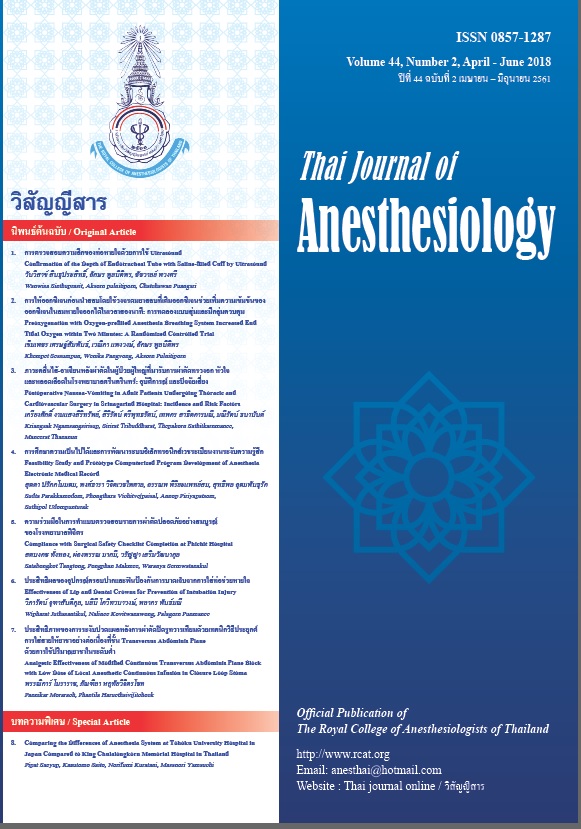Analgesic Effectiveness of Modified Continuous Transversus Abdominis Plane Block with Low Dose of Local Anesthetic Continuous Infusion in Closure Loop Stoma
Main Article Content
Abstract
Background: Postoperative pain is a major suffering of
the patients undergoing closure loop stoma. Transversus
abdominis plane (TAP) block was introduced as an
alternative analgesia for abdominal surgery. Regarding
continuous TAP block, we modified a catheter insertion
technique into TAP plane by a surgeon under direct
visualization. This study aimed to evaluate the analgesic
effectiveness of modified continuous TAP block (MCTAP)
compared with opioid-based analgesia in stoma reversal
patients.
Methods: Patients undergoing closure loop stoma during
January 2014 and December 2015 were examined and
divided into two groups. Patients receiving MCTAP block
with bupivacaine 0.2% (2 mL/h) over three consecutive
postoperative days were enrolled in MCTAP group. While
patients receiving opioid-based analgesia were enrolled in
conventional group. Opioid consumption, numeric rating
pain scores (NRPS) over three consecutive postoperative
days (POD), times to bowel function recovery were
recorded.
Results: A total of 42 patients were enrolled into MCTAP
group (20) and conventional group (22). Total morphine
consumption in MCTAP patients was significantly lower
than conventional patients (7.4, 19.59 mg respectively,
P<0.005). No significant difference was detected in NRPS.
The median of time to first flatus, time to first liquid intake,
and postoperative length of stay was significantly less in
MCTAP patients (35 and 42 h; P <0.05, 41 and 46.5 h;
P <0.05, 85 and 96 h; P <0.01, respectively).
Conclusions: MCTAP block with low dose local
anesthetics is an effective analgesia in closure loop stoma
and may also be a useful alternative analgesia regarding
to ERAS concepts.
Article Details
References
Intravenous or Epidural Patient-controlled Analgesia in the
Elderly after Major Abdominal Surgery. Anesthesiology 2000;
92: 433-41.
2. Kehlet H, Jensen TS, Woolf CJ. Persisitent postsurgical pain:
risk factors and prevention. Lancet 2006; 367: 1618-25.
3. Maeda A, Shibata SC, Wada H, et al. The efficacy of
continuous subcostal transversus abdominis plane block for
analgesia after living liver donation: a retrospective study.
J Anesth 2016;30:39-46.
4. Parikh BK, Waghmare V, Shah VR, et al. The analgesic
efficacy of continuous transversus abdominis plane block in
renal transplant recipients. J Anaesthesiol Clin Pharmacol.
2015;31:531-4.
5. Farag E, Guirguis MN, Helou M, et al. Continuous transversus
abdominis plane block catheter analgesia for postoperative
pain control in renal transplant. J Anesth.2015;29:4-8.
Jankovic ZB, Pollard SG, Nachiappan MM. Continuous
Transversus Abdominis Plane Block for Renal Transplant
Recipients. Anesth Analg 2009; 109: 1710-1.


